Comparative Analysis of Print Advertising Effectiveness in Marketing
VerifiedAdded on 2020/05/11
|12
|3136
|141
Report
AI Summary
This report provides a comparative analysis of print advertising effectiveness, focusing on two sets of advertisements for different products. The analysis evaluates the message, target audience, and persuasive tactics employed in each advertisement. The report explores the concepts of brand recall and persuasion, key metrics for measuring advertising success. It uses the AIDA model to assess the effectiveness of each advertisement in grabbing attention, generating interest, creating desire, and prompting action. The report compares the effectiveness of advertisements for health drinks (Tropicana vs. Capri Sun) and zip lock bags (Glad Head Stand vs. Ziploc EZ), providing recommendations for improvement and concluding with an assessment of overall advertising effectiveness. The report also includes tables summarizing the evaluation criteria and effectiveness ratings for each advertisement.
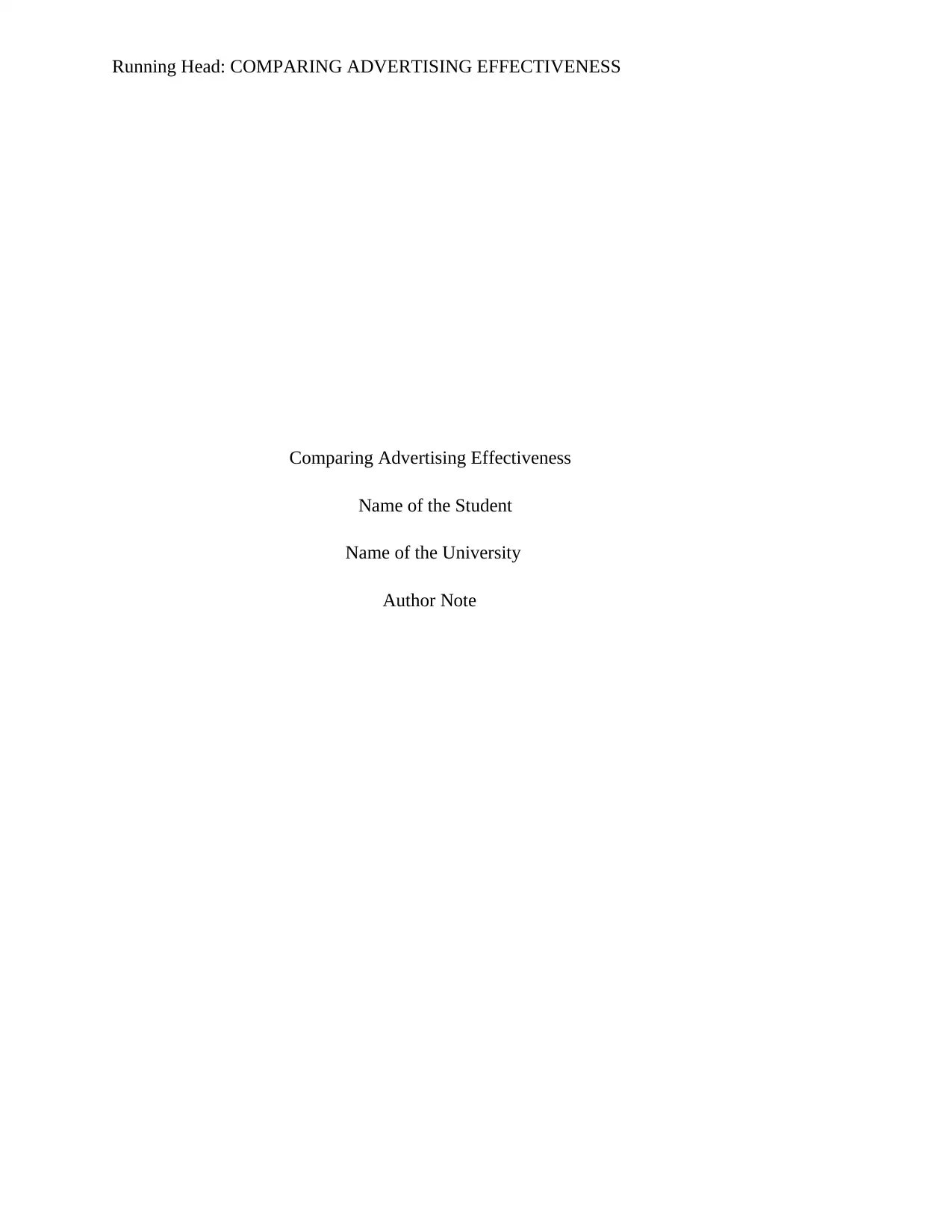
Running Head: COMPARING ADVERTISING EFFECTIVENESS
Comparing Advertising Effectiveness
Name of the Student
Name of the University
Author Note
Comparing Advertising Effectiveness
Name of the Student
Name of the University
Author Note
Paraphrase This Document
Need a fresh take? Get an instant paraphrase of this document with our AI Paraphraser
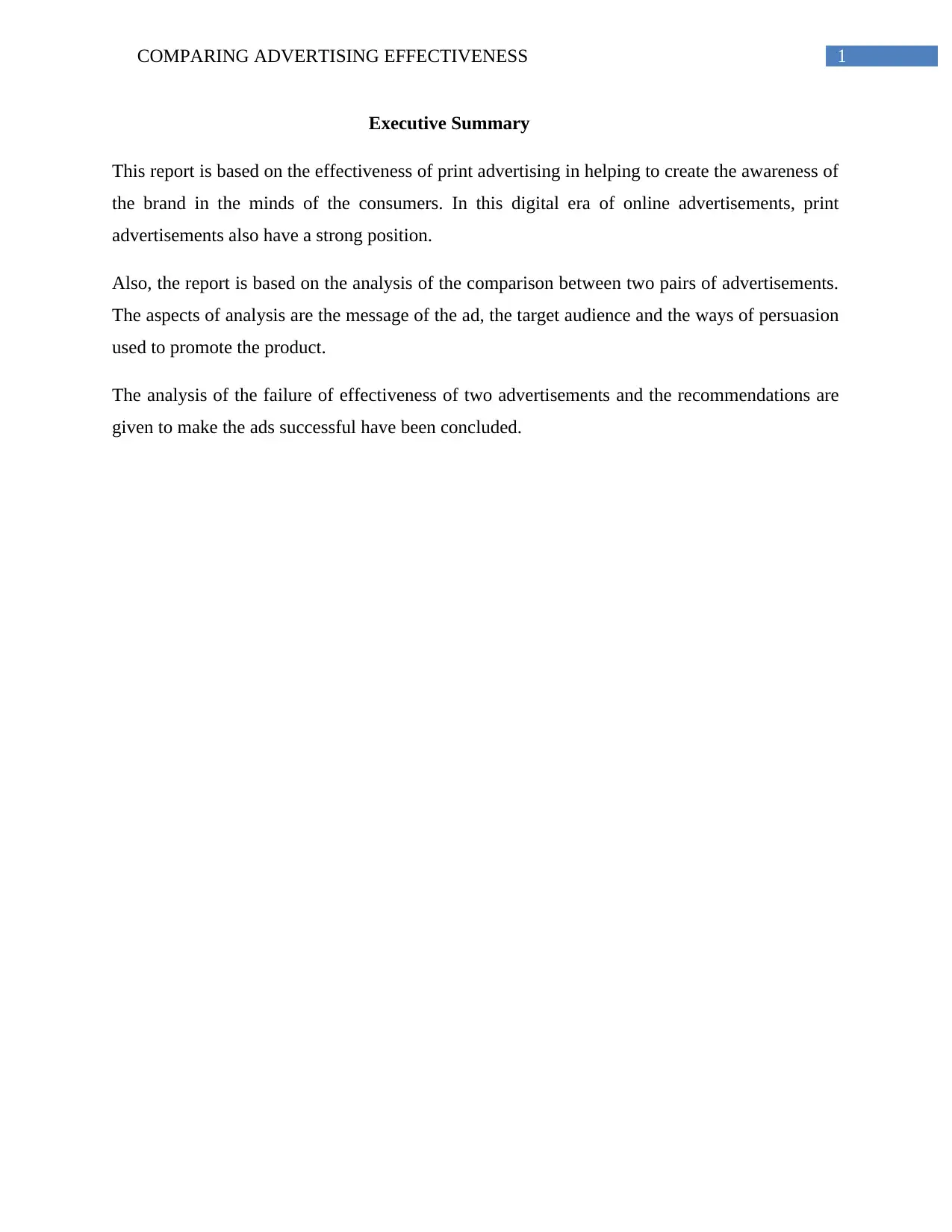
1COMPARING ADVERTISING EFFECTIVENESS
Executive Summary
This report is based on the effectiveness of print advertising in helping to create the awareness of
the brand in the minds of the consumers. In this digital era of online advertisements, print
advertisements also have a strong position.
Also, the report is based on the analysis of the comparison between two pairs of advertisements.
The aspects of analysis are the message of the ad, the target audience and the ways of persuasion
used to promote the product.
The analysis of the failure of effectiveness of two advertisements and the recommendations are
given to make the ads successful have been concluded.
Executive Summary
This report is based on the effectiveness of print advertising in helping to create the awareness of
the brand in the minds of the consumers. In this digital era of online advertisements, print
advertisements also have a strong position.
Also, the report is based on the analysis of the comparison between two pairs of advertisements.
The aspects of analysis are the message of the ad, the target audience and the ways of persuasion
used to promote the product.
The analysis of the failure of effectiveness of two advertisements and the recommendations are
given to make the ads successful have been concluded.
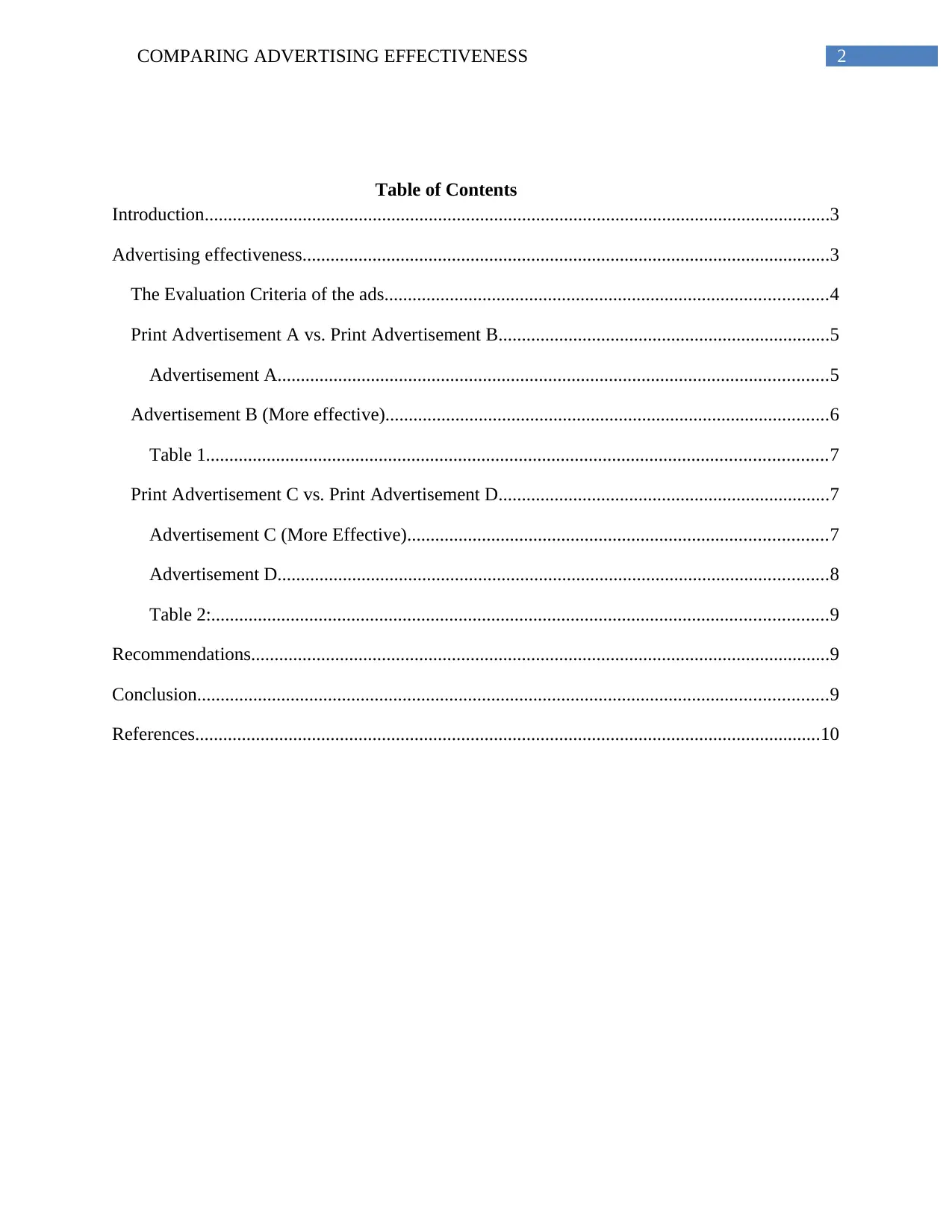
2COMPARING ADVERTISING EFFECTIVENESS
Table of Contents
Introduction......................................................................................................................................3
Advertising effectiveness.................................................................................................................3
The Evaluation Criteria of the ads...............................................................................................4
Print Advertisement A vs. Print Advertisement B.......................................................................5
Advertisement A......................................................................................................................5
Advertisement B (More effective)...............................................................................................6
Table 1.....................................................................................................................................7
Print Advertisement C vs. Print Advertisement D.......................................................................7
Advertisement C (More Effective)..........................................................................................7
Advertisement D......................................................................................................................8
Table 2:....................................................................................................................................9
Recommendations............................................................................................................................9
Conclusion.......................................................................................................................................9
References......................................................................................................................................10
Table of Contents
Introduction......................................................................................................................................3
Advertising effectiveness.................................................................................................................3
The Evaluation Criteria of the ads...............................................................................................4
Print Advertisement A vs. Print Advertisement B.......................................................................5
Advertisement A......................................................................................................................5
Advertisement B (More effective)...............................................................................................6
Table 1.....................................................................................................................................7
Print Advertisement C vs. Print Advertisement D.......................................................................7
Advertisement C (More Effective)..........................................................................................7
Advertisement D......................................................................................................................8
Table 2:....................................................................................................................................9
Recommendations............................................................................................................................9
Conclusion.......................................................................................................................................9
References......................................................................................................................................10
⊘ This is a preview!⊘
Do you want full access?
Subscribe today to unlock all pages.

Trusted by 1+ million students worldwide
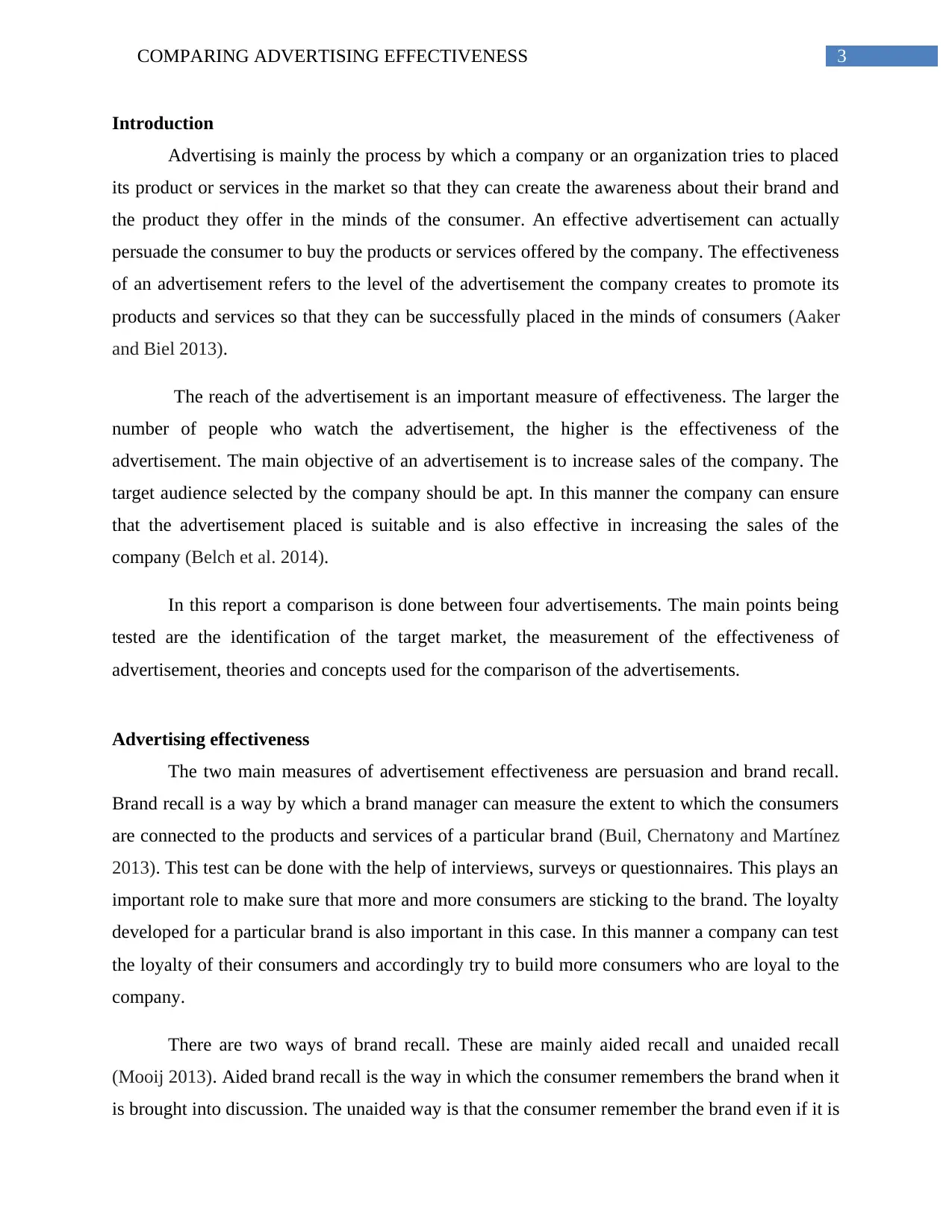
3COMPARING ADVERTISING EFFECTIVENESS
Introduction
Advertising is mainly the process by which a company or an organization tries to placed
its product or services in the market so that they can create the awareness about their brand and
the product they offer in the minds of the consumer. An effective advertisement can actually
persuade the consumer to buy the products or services offered by the company. The effectiveness
of an advertisement refers to the level of the advertisement the company creates to promote its
products and services so that they can be successfully placed in the minds of consumers (Aaker
and Biel 2013).
The reach of the advertisement is an important measure of effectiveness. The larger the
number of people who watch the advertisement, the higher is the effectiveness of the
advertisement. The main objective of an advertisement is to increase sales of the company. The
target audience selected by the company should be apt. In this manner the company can ensure
that the advertisement placed is suitable and is also effective in increasing the sales of the
company (Belch et al. 2014).
In this report a comparison is done between four advertisements. The main points being
tested are the identification of the target market, the measurement of the effectiveness of
advertisement, theories and concepts used for the comparison of the advertisements.
Advertising effectiveness
The two main measures of advertisement effectiveness are persuasion and brand recall.
Brand recall is a way by which a brand manager can measure the extent to which the consumers
are connected to the products and services of a particular brand (Buil, Chernatony and Martínez
2013). This test can be done with the help of interviews, surveys or questionnaires. This plays an
important role to make sure that more and more consumers are sticking to the brand. The loyalty
developed for a particular brand is also important in this case. In this manner a company can test
the loyalty of their consumers and accordingly try to build more consumers who are loyal to the
company.
There are two ways of brand recall. These are mainly aided recall and unaided recall
(Mooij 2013). Aided brand recall is the way in which the consumer remembers the brand when it
is brought into discussion. The unaided way is that the consumer remember the brand even if it is
Introduction
Advertising is mainly the process by which a company or an organization tries to placed
its product or services in the market so that they can create the awareness about their brand and
the product they offer in the minds of the consumer. An effective advertisement can actually
persuade the consumer to buy the products or services offered by the company. The effectiveness
of an advertisement refers to the level of the advertisement the company creates to promote its
products and services so that they can be successfully placed in the minds of consumers (Aaker
and Biel 2013).
The reach of the advertisement is an important measure of effectiveness. The larger the
number of people who watch the advertisement, the higher is the effectiveness of the
advertisement. The main objective of an advertisement is to increase sales of the company. The
target audience selected by the company should be apt. In this manner the company can ensure
that the advertisement placed is suitable and is also effective in increasing the sales of the
company (Belch et al. 2014).
In this report a comparison is done between four advertisements. The main points being
tested are the identification of the target market, the measurement of the effectiveness of
advertisement, theories and concepts used for the comparison of the advertisements.
Advertising effectiveness
The two main measures of advertisement effectiveness are persuasion and brand recall.
Brand recall is a way by which a brand manager can measure the extent to which the consumers
are connected to the products and services of a particular brand (Buil, Chernatony and Martínez
2013). This test can be done with the help of interviews, surveys or questionnaires. This plays an
important role to make sure that more and more consumers are sticking to the brand. The loyalty
developed for a particular brand is also important in this case. In this manner a company can test
the loyalty of their consumers and accordingly try to build more consumers who are loyal to the
company.
There are two ways of brand recall. These are mainly aided recall and unaided recall
(Mooij 2013). Aided brand recall is the way in which the consumer remembers the brand when it
is brought into discussion. The unaided way is that the consumer remember the brand even if it is
Paraphrase This Document
Need a fresh take? Get an instant paraphrase of this document with our AI Paraphraser
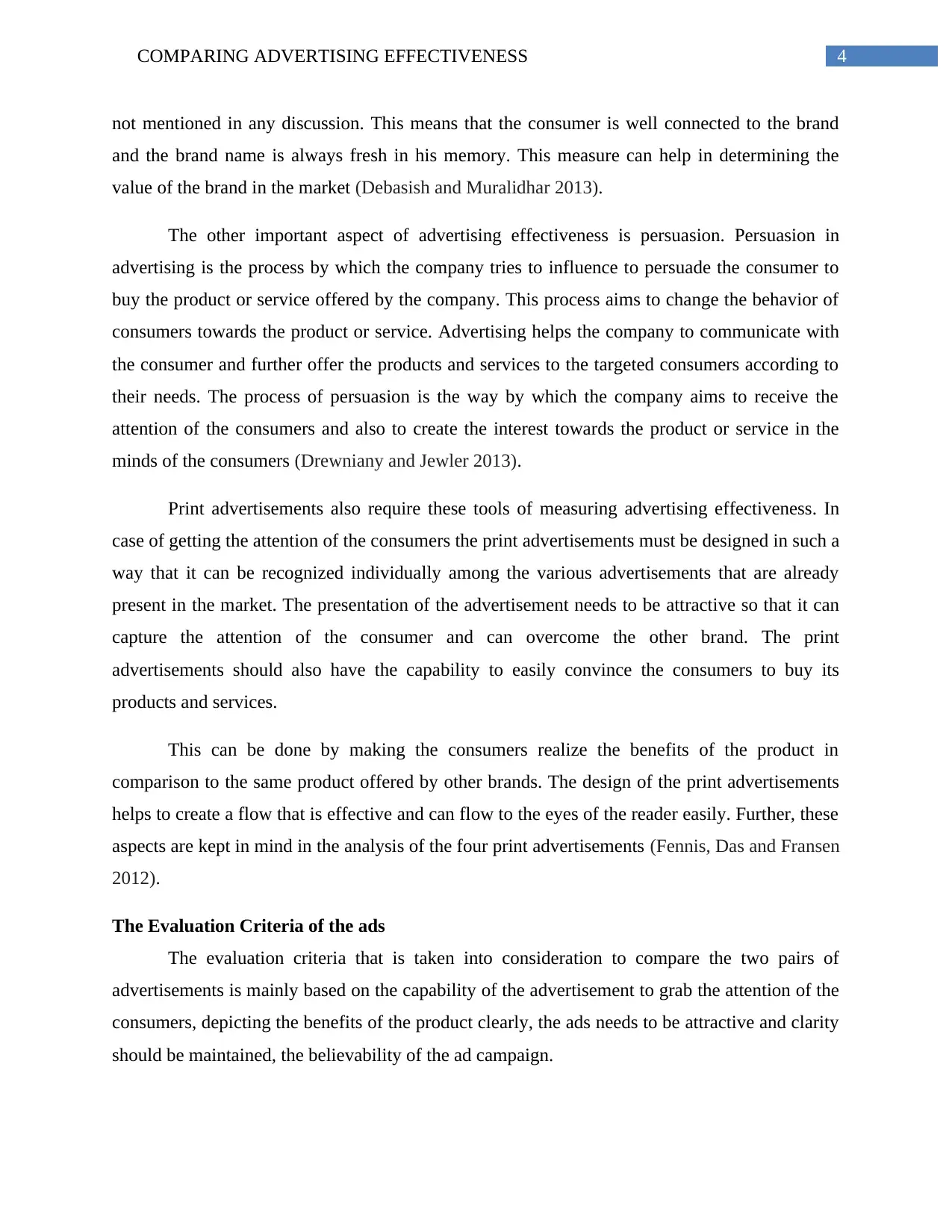
4COMPARING ADVERTISING EFFECTIVENESS
not mentioned in any discussion. This means that the consumer is well connected to the brand
and the brand name is always fresh in his memory. This measure can help in determining the
value of the brand in the market (Debasish and Muralidhar 2013).
The other important aspect of advertising effectiveness is persuasion. Persuasion in
advertising is the process by which the company tries to influence to persuade the consumer to
buy the product or service offered by the company. This process aims to change the behavior of
consumers towards the product or service. Advertising helps the company to communicate with
the consumer and further offer the products and services to the targeted consumers according to
their needs. The process of persuasion is the way by which the company aims to receive the
attention of the consumers and also to create the interest towards the product or service in the
minds of the consumers (Drewniany and Jewler 2013).
Print advertisements also require these tools of measuring advertising effectiveness. In
case of getting the attention of the consumers the print advertisements must be designed in such a
way that it can be recognized individually among the various advertisements that are already
present in the market. The presentation of the advertisement needs to be attractive so that it can
capture the attention of the consumer and can overcome the other brand. The print
advertisements should also have the capability to easily convince the consumers to buy its
products and services.
This can be done by making the consumers realize the benefits of the product in
comparison to the same product offered by other brands. The design of the print advertisements
helps to create a flow that is effective and can flow to the eyes of the reader easily. Further, these
aspects are kept in mind in the analysis of the four print advertisements (Fennis, Das and Fransen
2012).
The Evaluation Criteria of the ads
The evaluation criteria that is taken into consideration to compare the two pairs of
advertisements is mainly based on the capability of the advertisement to grab the attention of the
consumers, depicting the benefits of the product clearly, the ads needs to be attractive and clarity
should be maintained, the believability of the ad campaign.
not mentioned in any discussion. This means that the consumer is well connected to the brand
and the brand name is always fresh in his memory. This measure can help in determining the
value of the brand in the market (Debasish and Muralidhar 2013).
The other important aspect of advertising effectiveness is persuasion. Persuasion in
advertising is the process by which the company tries to influence to persuade the consumer to
buy the product or service offered by the company. This process aims to change the behavior of
consumers towards the product or service. Advertising helps the company to communicate with
the consumer and further offer the products and services to the targeted consumers according to
their needs. The process of persuasion is the way by which the company aims to receive the
attention of the consumers and also to create the interest towards the product or service in the
minds of the consumers (Drewniany and Jewler 2013).
Print advertisements also require these tools of measuring advertising effectiveness. In
case of getting the attention of the consumers the print advertisements must be designed in such a
way that it can be recognized individually among the various advertisements that are already
present in the market. The presentation of the advertisement needs to be attractive so that it can
capture the attention of the consumer and can overcome the other brand. The print
advertisements should also have the capability to easily convince the consumers to buy its
products and services.
This can be done by making the consumers realize the benefits of the product in
comparison to the same product offered by other brands. The design of the print advertisements
helps to create a flow that is effective and can flow to the eyes of the reader easily. Further, these
aspects are kept in mind in the analysis of the four print advertisements (Fennis, Das and Fransen
2012).
The Evaluation Criteria of the ads
The evaluation criteria that is taken into consideration to compare the two pairs of
advertisements is mainly based on the capability of the advertisement to grab the attention of the
consumers, depicting the benefits of the product clearly, the ads needs to be attractive and clarity
should be maintained, the believability of the ad campaign.
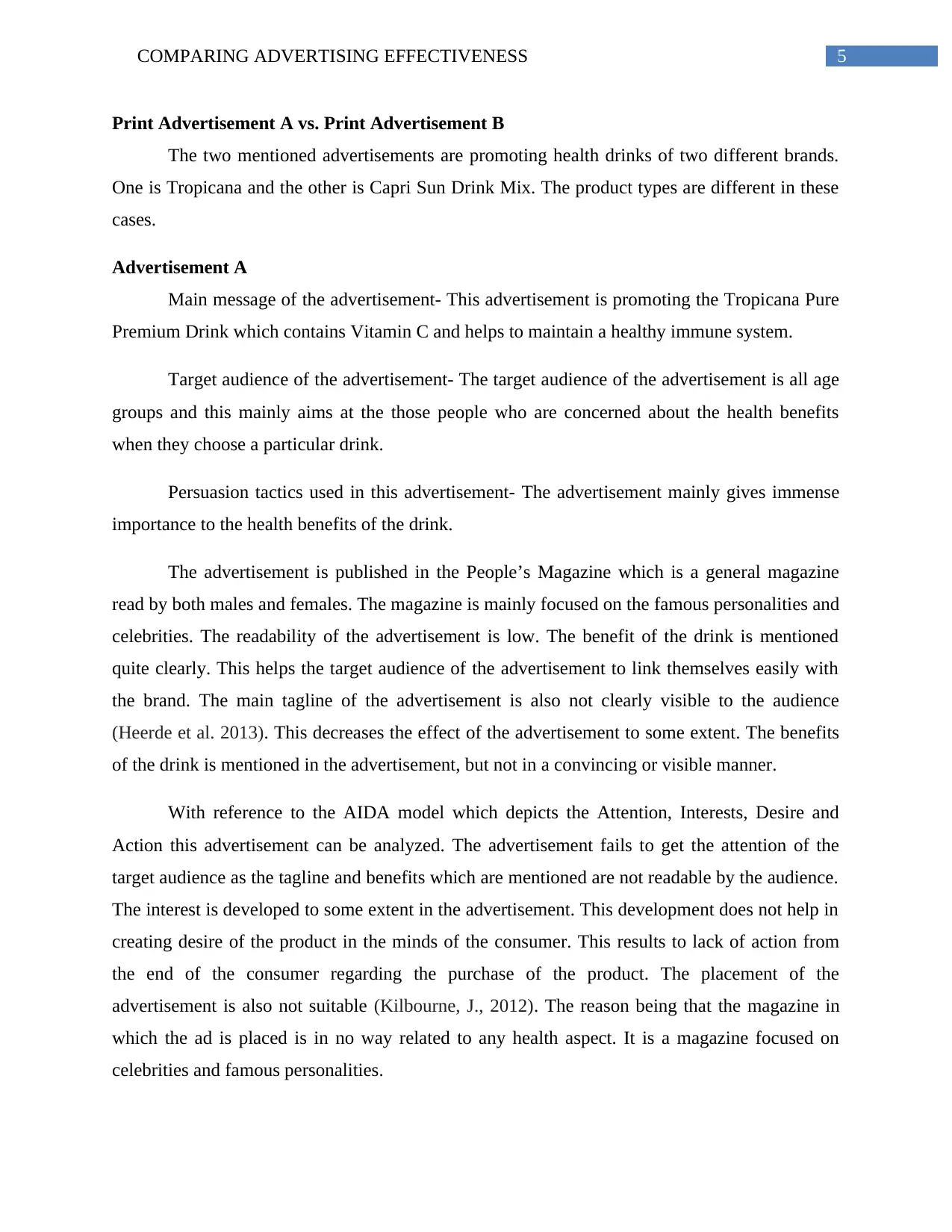
5COMPARING ADVERTISING EFFECTIVENESS
Print Advertisement A vs. Print Advertisement B
The two mentioned advertisements are promoting health drinks of two different brands.
One is Tropicana and the other is Capri Sun Drink Mix. The product types are different in these
cases.
Advertisement A
Main message of the advertisement- This advertisement is promoting the Tropicana Pure
Premium Drink which contains Vitamin C and helps to maintain a healthy immune system.
Target audience of the advertisement- The target audience of the advertisement is all age
groups and this mainly aims at the those people who are concerned about the health benefits
when they choose a particular drink.
Persuasion tactics used in this advertisement- The advertisement mainly gives immense
importance to the health benefits of the drink.
The advertisement is published in the People’s Magazine which is a general magazine
read by both males and females. The magazine is mainly focused on the famous personalities and
celebrities. The readability of the advertisement is low. The benefit of the drink is mentioned
quite clearly. This helps the target audience of the advertisement to link themselves easily with
the brand. The main tagline of the advertisement is also not clearly visible to the audience
(Heerde et al. 2013). This decreases the effect of the advertisement to some extent. The benefits
of the drink is mentioned in the advertisement, but not in a convincing or visible manner.
With reference to the AIDA model which depicts the Attention, Interests, Desire and
Action this advertisement can be analyzed. The advertisement fails to get the attention of the
target audience as the tagline and benefits which are mentioned are not readable by the audience.
The interest is developed to some extent in the advertisement. This development does not help in
creating desire of the product in the minds of the consumer. This results to lack of action from
the end of the consumer regarding the purchase of the product. The placement of the
advertisement is also not suitable (Kilbourne, J., 2012). The reason being that the magazine in
which the ad is placed is in no way related to any health aspect. It is a magazine focused on
celebrities and famous personalities.
Print Advertisement A vs. Print Advertisement B
The two mentioned advertisements are promoting health drinks of two different brands.
One is Tropicana and the other is Capri Sun Drink Mix. The product types are different in these
cases.
Advertisement A
Main message of the advertisement- This advertisement is promoting the Tropicana Pure
Premium Drink which contains Vitamin C and helps to maintain a healthy immune system.
Target audience of the advertisement- The target audience of the advertisement is all age
groups and this mainly aims at the those people who are concerned about the health benefits
when they choose a particular drink.
Persuasion tactics used in this advertisement- The advertisement mainly gives immense
importance to the health benefits of the drink.
The advertisement is published in the People’s Magazine which is a general magazine
read by both males and females. The magazine is mainly focused on the famous personalities and
celebrities. The readability of the advertisement is low. The benefit of the drink is mentioned
quite clearly. This helps the target audience of the advertisement to link themselves easily with
the brand. The main tagline of the advertisement is also not clearly visible to the audience
(Heerde et al. 2013). This decreases the effect of the advertisement to some extent. The benefits
of the drink is mentioned in the advertisement, but not in a convincing or visible manner.
With reference to the AIDA model which depicts the Attention, Interests, Desire and
Action this advertisement can be analyzed. The advertisement fails to get the attention of the
target audience as the tagline and benefits which are mentioned are not readable by the audience.
The interest is developed to some extent in the advertisement. This development does not help in
creating desire of the product in the minds of the consumer. This results to lack of action from
the end of the consumer regarding the purchase of the product. The placement of the
advertisement is also not suitable (Kilbourne, J., 2012). The reason being that the magazine in
which the ad is placed is in no way related to any health aspect. It is a magazine focused on
celebrities and famous personalities.
⊘ This is a preview!⊘
Do you want full access?
Subscribe today to unlock all pages.

Trusted by 1+ million students worldwide
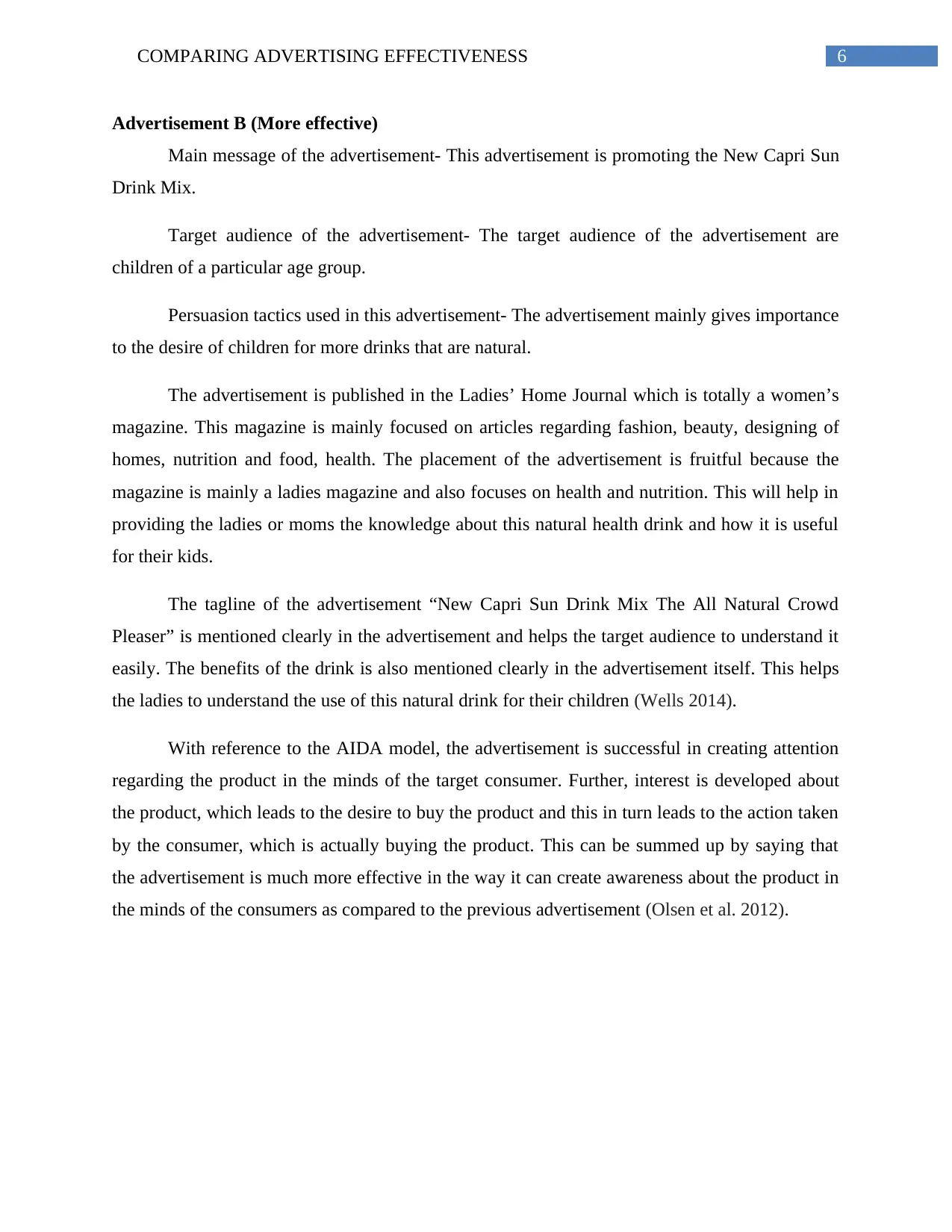
6COMPARING ADVERTISING EFFECTIVENESS
Advertisement B (More effective)
Main message of the advertisement- This advertisement is promoting the New Capri Sun
Drink Mix.
Target audience of the advertisement- The target audience of the advertisement are
children of a particular age group.
Persuasion tactics used in this advertisement- The advertisement mainly gives importance
to the desire of children for more drinks that are natural.
The advertisement is published in the Ladies’ Home Journal which is totally a women’s
magazine. This magazine is mainly focused on articles regarding fashion, beauty, designing of
homes, nutrition and food, health. The placement of the advertisement is fruitful because the
magazine is mainly a ladies magazine and also focuses on health and nutrition. This will help in
providing the ladies or moms the knowledge about this natural health drink and how it is useful
for their kids.
The tagline of the advertisement “New Capri Sun Drink Mix The All Natural Crowd
Pleaser” is mentioned clearly in the advertisement and helps the target audience to understand it
easily. The benefits of the drink is also mentioned clearly in the advertisement itself. This helps
the ladies to understand the use of this natural drink for their children (Wells 2014).
With reference to the AIDA model, the advertisement is successful in creating attention
regarding the product in the minds of the target consumer. Further, interest is developed about
the product, which leads to the desire to buy the product and this in turn leads to the action taken
by the consumer, which is actually buying the product. This can be summed up by saying that
the advertisement is much more effective in the way it can create awareness about the product in
the minds of the consumers as compared to the previous advertisement (Olsen et al. 2012).
Advertisement B (More effective)
Main message of the advertisement- This advertisement is promoting the New Capri Sun
Drink Mix.
Target audience of the advertisement- The target audience of the advertisement are
children of a particular age group.
Persuasion tactics used in this advertisement- The advertisement mainly gives importance
to the desire of children for more drinks that are natural.
The advertisement is published in the Ladies’ Home Journal which is totally a women’s
magazine. This magazine is mainly focused on articles regarding fashion, beauty, designing of
homes, nutrition and food, health. The placement of the advertisement is fruitful because the
magazine is mainly a ladies magazine and also focuses on health and nutrition. This will help in
providing the ladies or moms the knowledge about this natural health drink and how it is useful
for their kids.
The tagline of the advertisement “New Capri Sun Drink Mix The All Natural Crowd
Pleaser” is mentioned clearly in the advertisement and helps the target audience to understand it
easily. The benefits of the drink is also mentioned clearly in the advertisement itself. This helps
the ladies to understand the use of this natural drink for their children (Wells 2014).
With reference to the AIDA model, the advertisement is successful in creating attention
regarding the product in the minds of the target consumer. Further, interest is developed about
the product, which leads to the desire to buy the product and this in turn leads to the action taken
by the consumer, which is actually buying the product. This can be summed up by saying that
the advertisement is much more effective in the way it can create awareness about the product in
the minds of the consumers as compared to the previous advertisement (Olsen et al. 2012).
Paraphrase This Document
Need a fresh take? Get an instant paraphrase of this document with our AI Paraphraser
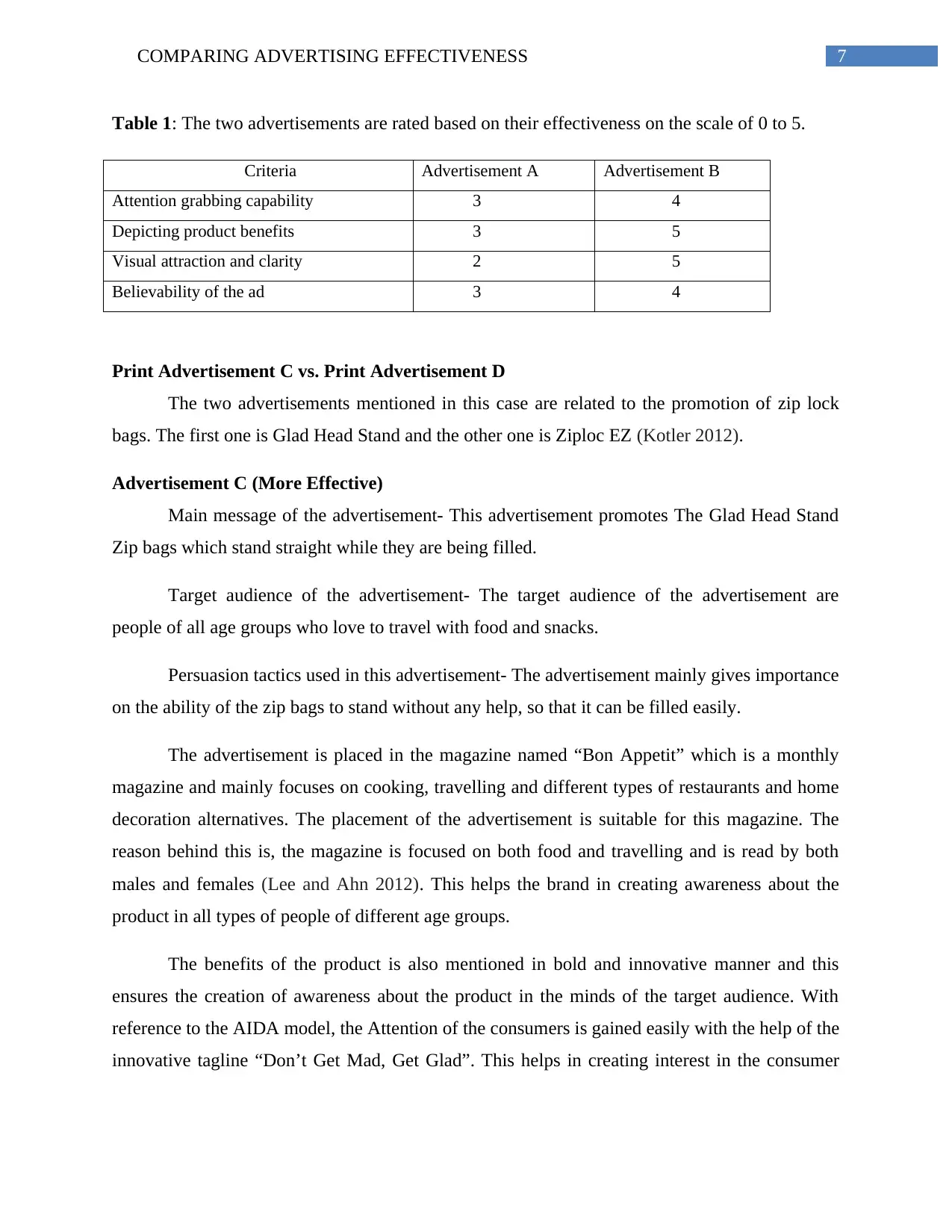
7COMPARING ADVERTISING EFFECTIVENESS
Table 1: The two advertisements are rated based on their effectiveness on the scale of 0 to 5.
Criteria Advertisement A Advertisement B
Attention grabbing capability 3 4
Depicting product benefits 3 5
Visual attraction and clarity 2 5
Believability of the ad 3 4
Print Advertisement C vs. Print Advertisement D
The two advertisements mentioned in this case are related to the promotion of zip lock
bags. The first one is Glad Head Stand and the other one is Ziploc EZ (Kotler 2012).
Advertisement C (More Effective)
Main message of the advertisement- This advertisement promotes The Glad Head Stand
Zip bags which stand straight while they are being filled.
Target audience of the advertisement- The target audience of the advertisement are
people of all age groups who love to travel with food and snacks.
Persuasion tactics used in this advertisement- The advertisement mainly gives importance
on the ability of the zip bags to stand without any help, so that it can be filled easily.
The advertisement is placed in the magazine named “Bon Appetit” which is a monthly
magazine and mainly focuses on cooking, travelling and different types of restaurants and home
decoration alternatives. The placement of the advertisement is suitable for this magazine. The
reason behind this is, the magazine is focused on both food and travelling and is read by both
males and females (Lee and Ahn 2012). This helps the brand in creating awareness about the
product in all types of people of different age groups.
The benefits of the product is also mentioned in bold and innovative manner and this
ensures the creation of awareness about the product in the minds of the target audience. With
reference to the AIDA model, the Attention of the consumers is gained easily with the help of the
innovative tagline “Don’t Get Mad, Get Glad”. This helps in creating interest in the consumer
Table 1: The two advertisements are rated based on their effectiveness on the scale of 0 to 5.
Criteria Advertisement A Advertisement B
Attention grabbing capability 3 4
Depicting product benefits 3 5
Visual attraction and clarity 2 5
Believability of the ad 3 4
Print Advertisement C vs. Print Advertisement D
The two advertisements mentioned in this case are related to the promotion of zip lock
bags. The first one is Glad Head Stand and the other one is Ziploc EZ (Kotler 2012).
Advertisement C (More Effective)
Main message of the advertisement- This advertisement promotes The Glad Head Stand
Zip bags which stand straight while they are being filled.
Target audience of the advertisement- The target audience of the advertisement are
people of all age groups who love to travel with food and snacks.
Persuasion tactics used in this advertisement- The advertisement mainly gives importance
on the ability of the zip bags to stand without any help, so that it can be filled easily.
The advertisement is placed in the magazine named “Bon Appetit” which is a monthly
magazine and mainly focuses on cooking, travelling and different types of restaurants and home
decoration alternatives. The placement of the advertisement is suitable for this magazine. The
reason behind this is, the magazine is focused on both food and travelling and is read by both
males and females (Lee and Ahn 2012). This helps the brand in creating awareness about the
product in all types of people of different age groups.
The benefits of the product is also mentioned in bold and innovative manner and this
ensures the creation of awareness about the product in the minds of the target audience. With
reference to the AIDA model, the Attention of the consumers is gained easily with the help of the
innovative tagline “Don’t Get Mad, Get Glad”. This helps in creating interest in the consumer
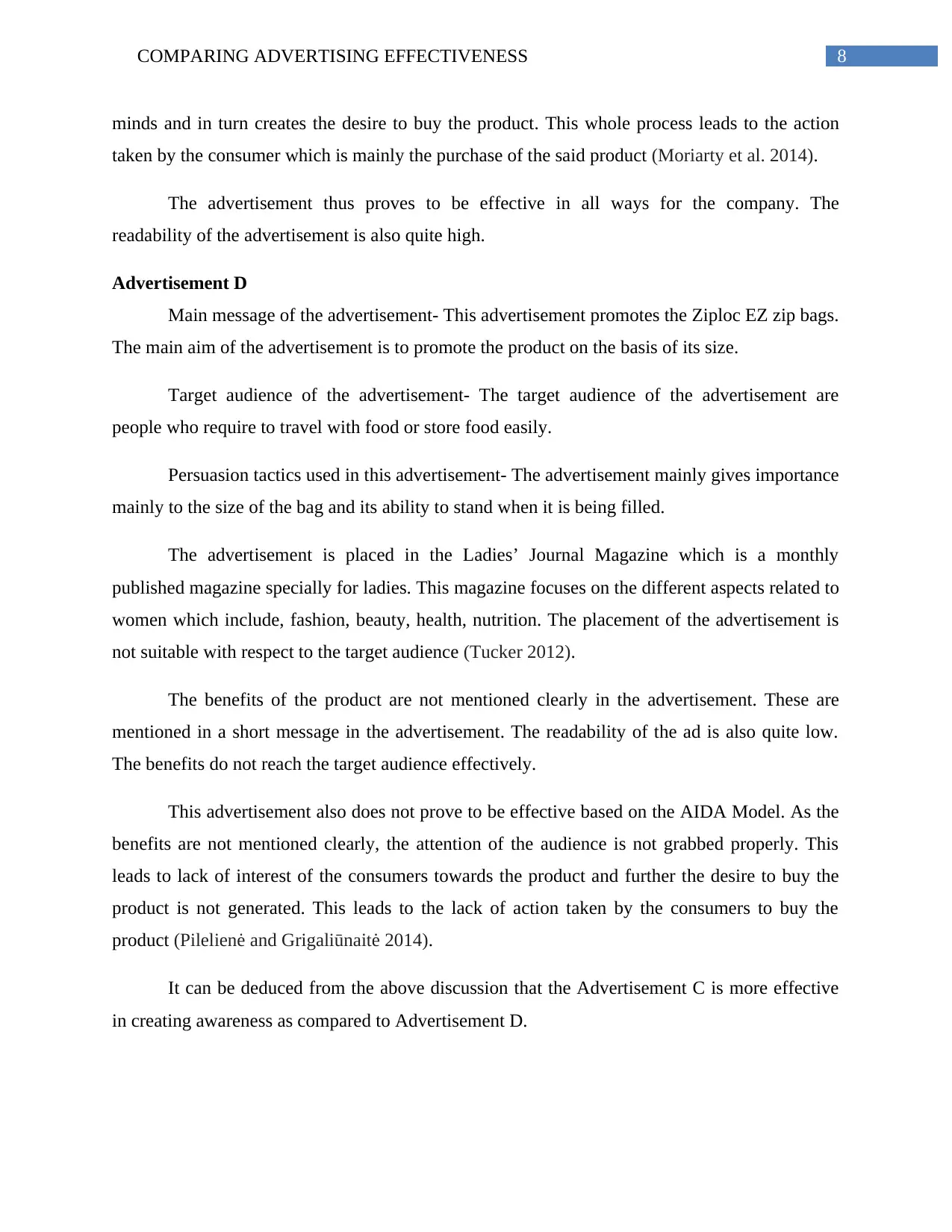
8COMPARING ADVERTISING EFFECTIVENESS
minds and in turn creates the desire to buy the product. This whole process leads to the action
taken by the consumer which is mainly the purchase of the said product (Moriarty et al. 2014).
The advertisement thus proves to be effective in all ways for the company. The
readability of the advertisement is also quite high.
Advertisement D
Main message of the advertisement- This advertisement promotes the Ziploc EZ zip bags.
The main aim of the advertisement is to promote the product on the basis of its size.
Target audience of the advertisement- The target audience of the advertisement are
people who require to travel with food or store food easily.
Persuasion tactics used in this advertisement- The advertisement mainly gives importance
mainly to the size of the bag and its ability to stand when it is being filled.
The advertisement is placed in the Ladies’ Journal Magazine which is a monthly
published magazine specially for ladies. This magazine focuses on the different aspects related to
women which include, fashion, beauty, health, nutrition. The placement of the advertisement is
not suitable with respect to the target audience (Tucker 2012).
The benefits of the product are not mentioned clearly in the advertisement. These are
mentioned in a short message in the advertisement. The readability of the ad is also quite low.
The benefits do not reach the target audience effectively.
This advertisement also does not prove to be effective based on the AIDA Model. As the
benefits are not mentioned clearly, the attention of the audience is not grabbed properly. This
leads to lack of interest of the consumers towards the product and further the desire to buy the
product is not generated. This leads to the lack of action taken by the consumers to buy the
product (Pilelienė and Grigaliūnaitė 2014).
It can be deduced from the above discussion that the Advertisement C is more effective
in creating awareness as compared to Advertisement D.
minds and in turn creates the desire to buy the product. This whole process leads to the action
taken by the consumer which is mainly the purchase of the said product (Moriarty et al. 2014).
The advertisement thus proves to be effective in all ways for the company. The
readability of the advertisement is also quite high.
Advertisement D
Main message of the advertisement- This advertisement promotes the Ziploc EZ zip bags.
The main aim of the advertisement is to promote the product on the basis of its size.
Target audience of the advertisement- The target audience of the advertisement are
people who require to travel with food or store food easily.
Persuasion tactics used in this advertisement- The advertisement mainly gives importance
mainly to the size of the bag and its ability to stand when it is being filled.
The advertisement is placed in the Ladies’ Journal Magazine which is a monthly
published magazine specially for ladies. This magazine focuses on the different aspects related to
women which include, fashion, beauty, health, nutrition. The placement of the advertisement is
not suitable with respect to the target audience (Tucker 2012).
The benefits of the product are not mentioned clearly in the advertisement. These are
mentioned in a short message in the advertisement. The readability of the ad is also quite low.
The benefits do not reach the target audience effectively.
This advertisement also does not prove to be effective based on the AIDA Model. As the
benefits are not mentioned clearly, the attention of the audience is not grabbed properly. This
leads to lack of interest of the consumers towards the product and further the desire to buy the
product is not generated. This leads to the lack of action taken by the consumers to buy the
product (Pilelienė and Grigaliūnaitė 2014).
It can be deduced from the above discussion that the Advertisement C is more effective
in creating awareness as compared to Advertisement D.
⊘ This is a preview!⊘
Do you want full access?
Subscribe today to unlock all pages.

Trusted by 1+ million students worldwide
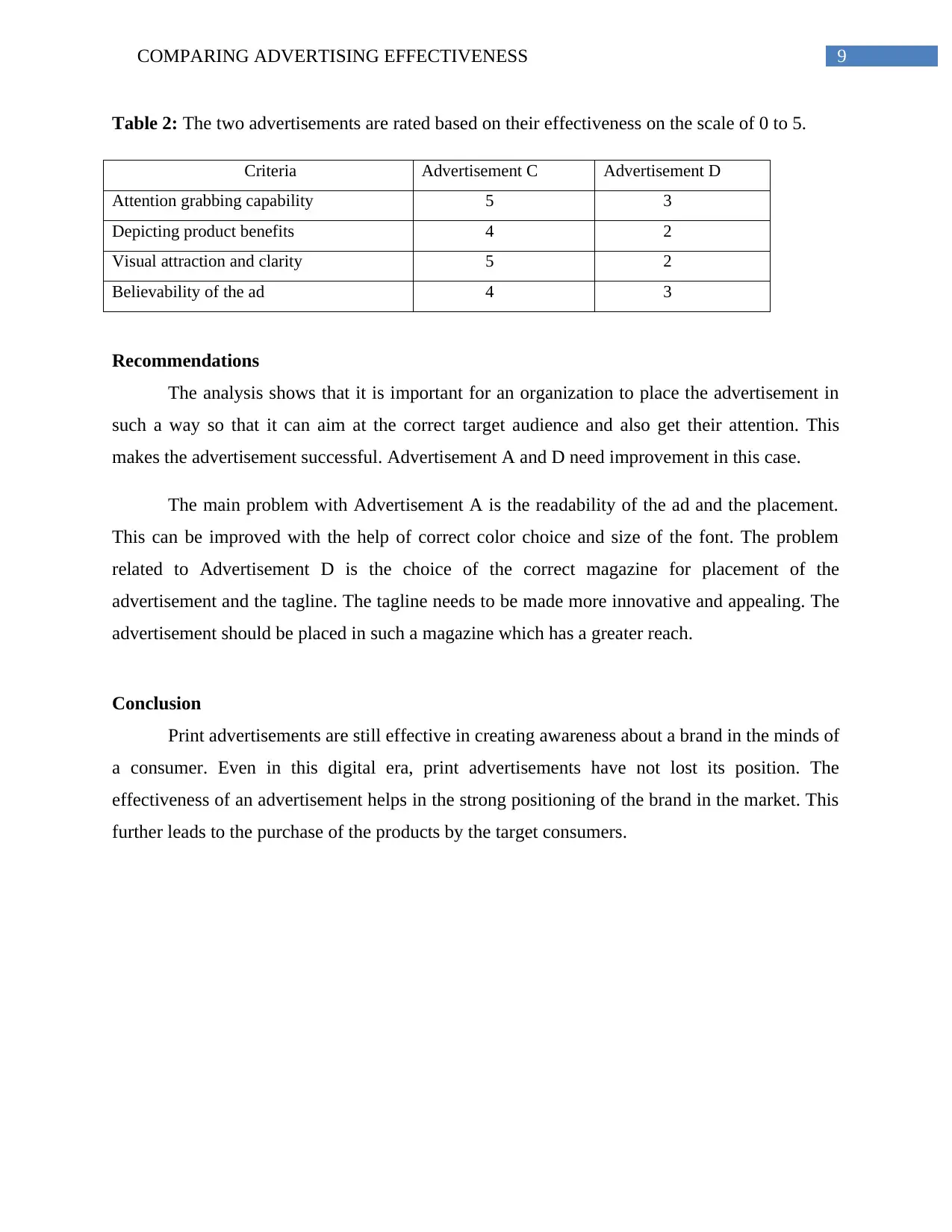
9COMPARING ADVERTISING EFFECTIVENESS
Table 2: The two advertisements are rated based on their effectiveness on the scale of 0 to 5.
Criteria Advertisement C Advertisement D
Attention grabbing capability 5 3
Depicting product benefits 4 2
Visual attraction and clarity 5 2
Believability of the ad 4 3
Recommendations
The analysis shows that it is important for an organization to place the advertisement in
such a way so that it can aim at the correct target audience and also get their attention. This
makes the advertisement successful. Advertisement A and D need improvement in this case.
The main problem with Advertisement A is the readability of the ad and the placement.
This can be improved with the help of correct color choice and size of the font. The problem
related to Advertisement D is the choice of the correct magazine for placement of the
advertisement and the tagline. The tagline needs to be made more innovative and appealing. The
advertisement should be placed in such a magazine which has a greater reach.
Conclusion
Print advertisements are still effective in creating awareness about a brand in the minds of
a consumer. Even in this digital era, print advertisements have not lost its position. The
effectiveness of an advertisement helps in the strong positioning of the brand in the market. This
further leads to the purchase of the products by the target consumers.
Table 2: The two advertisements are rated based on their effectiveness on the scale of 0 to 5.
Criteria Advertisement C Advertisement D
Attention grabbing capability 5 3
Depicting product benefits 4 2
Visual attraction and clarity 5 2
Believability of the ad 4 3
Recommendations
The analysis shows that it is important for an organization to place the advertisement in
such a way so that it can aim at the correct target audience and also get their attention. This
makes the advertisement successful. Advertisement A and D need improvement in this case.
The main problem with Advertisement A is the readability of the ad and the placement.
This can be improved with the help of correct color choice and size of the font. The problem
related to Advertisement D is the choice of the correct magazine for placement of the
advertisement and the tagline. The tagline needs to be made more innovative and appealing. The
advertisement should be placed in such a magazine which has a greater reach.
Conclusion
Print advertisements are still effective in creating awareness about a brand in the minds of
a consumer. Even in this digital era, print advertisements have not lost its position. The
effectiveness of an advertisement helps in the strong positioning of the brand in the market. This
further leads to the purchase of the products by the target consumers.
Paraphrase This Document
Need a fresh take? Get an instant paraphrase of this document with our AI Paraphraser
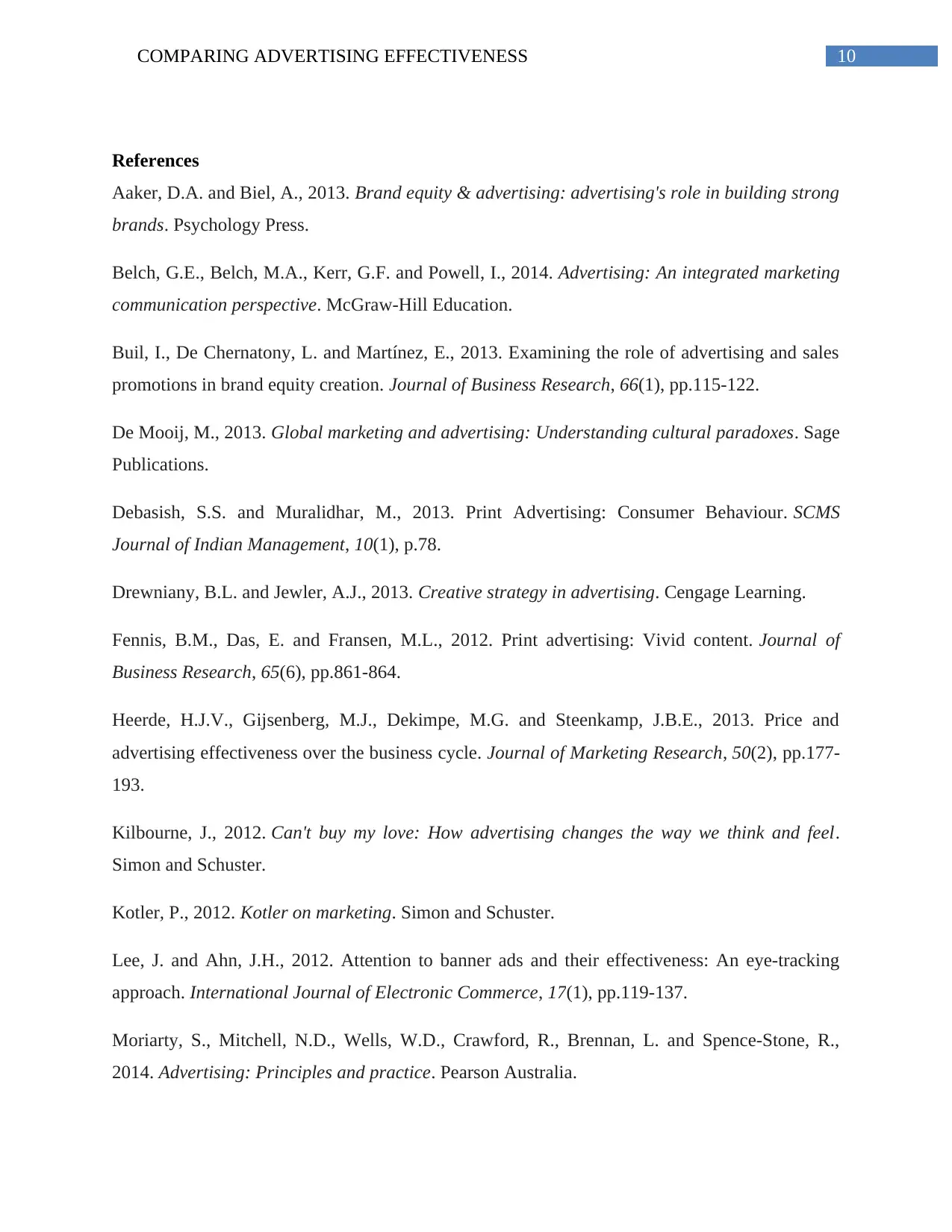
10COMPARING ADVERTISING EFFECTIVENESS
References
Aaker, D.A. and Biel, A., 2013. Brand equity & advertising: advertising's role in building strong
brands. Psychology Press.
Belch, G.E., Belch, M.A., Kerr, G.F. and Powell, I., 2014. Advertising: An integrated marketing
communication perspective. McGraw-Hill Education.
Buil, I., De Chernatony, L. and Martínez, E., 2013. Examining the role of advertising and sales
promotions in brand equity creation. Journal of Business Research, 66(1), pp.115-122.
De Mooij, M., 2013. Global marketing and advertising: Understanding cultural paradoxes. Sage
Publications.
Debasish, S.S. and Muralidhar, M., 2013. Print Advertising: Consumer Behaviour. SCMS
Journal of Indian Management, 10(1), p.78.
Drewniany, B.L. and Jewler, A.J., 2013. Creative strategy in advertising. Cengage Learning.
Fennis, B.M., Das, E. and Fransen, M.L., 2012. Print advertising: Vivid content. Journal of
Business Research, 65(6), pp.861-864.
Heerde, H.J.V., Gijsenberg, M.J., Dekimpe, M.G. and Steenkamp, J.B.E., 2013. Price and
advertising effectiveness over the business cycle. Journal of Marketing Research, 50(2), pp.177-
193.
Kilbourne, J., 2012. Can't buy my love: How advertising changes the way we think and feel.
Simon and Schuster.
Kotler, P., 2012. Kotler on marketing. Simon and Schuster.
Lee, J. and Ahn, J.H., 2012. Attention to banner ads and their effectiveness: An eye-tracking
approach. International Journal of Electronic Commerce, 17(1), pp.119-137.
Moriarty, S., Mitchell, N.D., Wells, W.D., Crawford, R., Brennan, L. and Spence-Stone, R.,
2014. Advertising: Principles and practice. Pearson Australia.
References
Aaker, D.A. and Biel, A., 2013. Brand equity & advertising: advertising's role in building strong
brands. Psychology Press.
Belch, G.E., Belch, M.A., Kerr, G.F. and Powell, I., 2014. Advertising: An integrated marketing
communication perspective. McGraw-Hill Education.
Buil, I., De Chernatony, L. and Martínez, E., 2013. Examining the role of advertising and sales
promotions in brand equity creation. Journal of Business Research, 66(1), pp.115-122.
De Mooij, M., 2013. Global marketing and advertising: Understanding cultural paradoxes. Sage
Publications.
Debasish, S.S. and Muralidhar, M., 2013. Print Advertising: Consumer Behaviour. SCMS
Journal of Indian Management, 10(1), p.78.
Drewniany, B.L. and Jewler, A.J., 2013. Creative strategy in advertising. Cengage Learning.
Fennis, B.M., Das, E. and Fransen, M.L., 2012. Print advertising: Vivid content. Journal of
Business Research, 65(6), pp.861-864.
Heerde, H.J.V., Gijsenberg, M.J., Dekimpe, M.G. and Steenkamp, J.B.E., 2013. Price and
advertising effectiveness over the business cycle. Journal of Marketing Research, 50(2), pp.177-
193.
Kilbourne, J., 2012. Can't buy my love: How advertising changes the way we think and feel.
Simon and Schuster.
Kotler, P., 2012. Kotler on marketing. Simon and Schuster.
Lee, J. and Ahn, J.H., 2012. Attention to banner ads and their effectiveness: An eye-tracking
approach. International Journal of Electronic Commerce, 17(1), pp.119-137.
Moriarty, S., Mitchell, N.D., Wells, W.D., Crawford, R., Brennan, L. and Spence-Stone, R.,
2014. Advertising: Principles and practice. Pearson Australia.
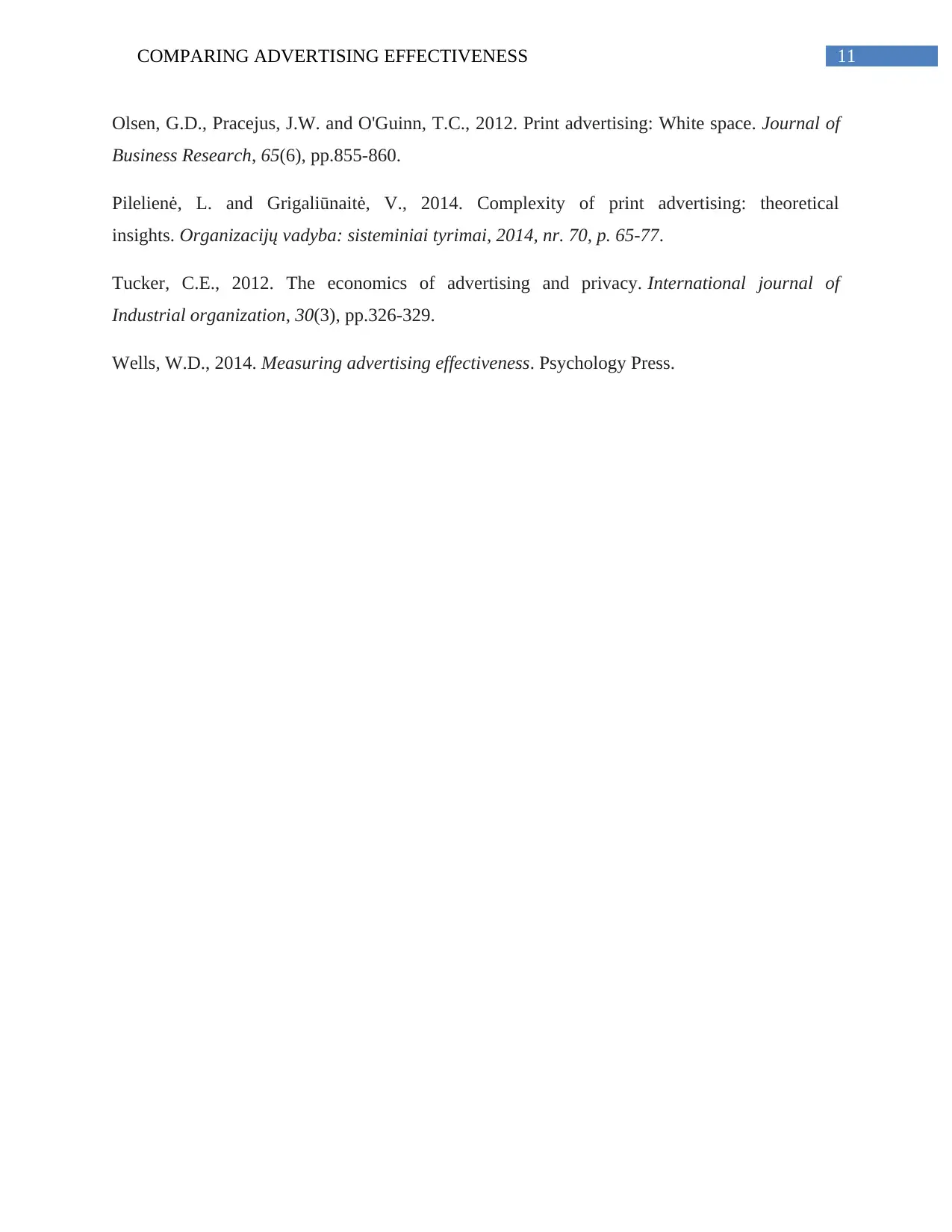
11COMPARING ADVERTISING EFFECTIVENESS
Olsen, G.D., Pracejus, J.W. and O'Guinn, T.C., 2012. Print advertising: White space. Journal of
Business Research, 65(6), pp.855-860.
Pilelienė, L. and Grigaliūnaitė, V., 2014. Complexity of print advertising: theoretical
insights. Organizacijų vadyba: sisteminiai tyrimai, 2014, nr. 70, p. 65-77.
Tucker, C.E., 2012. The economics of advertising and privacy. International journal of
Industrial organization, 30(3), pp.326-329.
Wells, W.D., 2014. Measuring advertising effectiveness. Psychology Press.
Olsen, G.D., Pracejus, J.W. and O'Guinn, T.C., 2012. Print advertising: White space. Journal of
Business Research, 65(6), pp.855-860.
Pilelienė, L. and Grigaliūnaitė, V., 2014. Complexity of print advertising: theoretical
insights. Organizacijų vadyba: sisteminiai tyrimai, 2014, nr. 70, p. 65-77.
Tucker, C.E., 2012. The economics of advertising and privacy. International journal of
Industrial organization, 30(3), pp.326-329.
Wells, W.D., 2014. Measuring advertising effectiveness. Psychology Press.
⊘ This is a preview!⊘
Do you want full access?
Subscribe today to unlock all pages.

Trusted by 1+ million students worldwide
1 out of 12
Related Documents
Your All-in-One AI-Powered Toolkit for Academic Success.
+13062052269
info@desklib.com
Available 24*7 on WhatsApp / Email
![[object Object]](/_next/static/media/star-bottom.7253800d.svg)
Unlock your academic potential
Copyright © 2020–2025 A2Z Services. All Rights Reserved. Developed and managed by ZUCOL.





